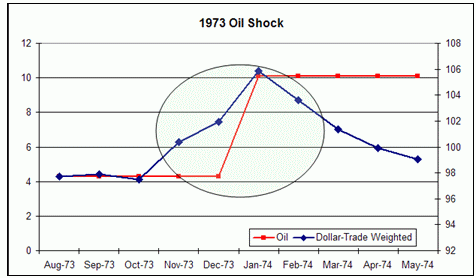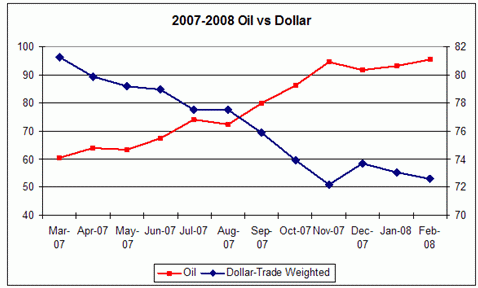|
Oil prices are rising and the US dollar is falling, but is this the natural relationship between these two assets? Taking a look back at the two prominent oil shocks of the past four decades (1973 and 1979), we see that this is not necessarily the case.
1973 Oil Crisis: Initially Dollar Bullish, Eventually Dollar Bearish
In 1973, oil prices jumped 134% when the members of the OAPEC, which is OPEC plus Egypt and Syria, announced that they were no longer shipping oil to nations that supported Israel in its conflict with Syria and Egypt. This effectively shut down exports to the US, Western Europe and Japan. As a result, prices rose significantly to account for the sharp reduction in supply. At the same time, Saudi Arabia, Iran, Iraq, Abu Dhabi, Kuwait, and Qatar unilaterally raised prices by 17 percent and announced production cuts after negotiations with major oil companies.
In response to this oil shock, the trade weighted US dollar index* as measured against the major currencies first strengthened alongside oil and then sold off immediately. At that time, the Federal Reserve was combating inflationary pressures by raising interest rates. The jump in crude exacerbated the need for further rate hikes, forcing the central bank to bring the Fed Funds target rate from 7.5 percent in May 1973 to a high of 13 percent by the summer of 1974. The focus on inflation was initially dollar bullish but once the rate hikes started to have a serious impact on US growth, the trend turned dollar bearish. Between the third quarter of 1973 and the first quarter of 1975, GDP growth contracted five out of the seven quarters and in response to the deterioration in growth, the US dollar erased all of its gains.
*Data on the Dollar Index and Oil Prices are from the St Louis Federal Reserve

1979 Oil Crisis: Initially Dollar Bullish, Eventually Dollar Bearish
The US’ second oil crisis in 1979 was triggered by the Iranian revolution and exacerbated by a gasoline shortage. OPEC raised prices by 14.5 percent on April 1st and the US Department of Energy announced phased oil price decontrols which involved the gradual increased of old oil price ceilings. Shortly thereafter, OEC raised prices a second time by 15 percent, the US halted imports from Iran, while Kuwait, Iran and Libya cut production. Saudi Arabia also eventually raised their market crude prices to $24 per barrel and because of all of these factors, crude oil prices increased 118 percent between January 1979 and December 1979.
The price action of the US dollar during that time was very similar to the price action of the greenback in 1973; it first rallied and then sold off. At that time, the Federal Reserve was also hiking interest rates to combat inflationary pressures and the oil price spike exacerbated their degree of rate hikes. Between January 1979 and December 1979, rates where taken from 10 percent to 14 percent and by March of 1980, the Fed Funds rate hit a high of 20 percent. Quarterly GDP growth dropped 7.8 percent in the second quarter of 1980, triggering the dollar’s demise.
1990 Oil Price Spike: Persistent Dollar Weakness
Between June and October of 1990, oil prices also jumped 113 percent as a result of the first Gulf War. Interestingly enough, the US dollar behaved very differently for two reasons. The first was the short-lived nature of the oil spike; prices started falling 6 months after the initial rise and the second was the Fed’s monetary policy cycle. Unlike the oil crisis of 1973 or 1979, the Federal Reserve started cutting interest rates before the spike and continued to reduce rates throughout 1990 and into 1991 and the dollar was already in a downtrend due to the loosening of monetary policy. The weakness continued as growth slowed with GDP remaining stagnant in third quarter of 1990, and then falling 3 and 2 percent respectively over the next two quarters.
2007 to 2008 Oil Rise
The characteristics surrounding the latest oil rise is more similar to the oil spike in 1990 than the shocks of 1973 and 1979. Therefore it is easy to understand why the US dollar has continued to weaken despite growing inflationary pressures. The Federal Reserve has been consistently cutting interest and these rate cuts have played a far more dominant role in the price action of the dollar than the rise in oil. The market basically doesn’t believe that the Fed will start raising interest rates – and they have good reason to feel this way because based upon the last 3 oil shocks, growth in coming quarters should contract. Back in the 1990s, the Fed took a break from cutting rates like they are expected to do in June, but they quickly resurrected their rate cuts as the economy slowed. Of course, interest rates were much higher then than they are now, but if growth does not pick up, more rate cuts may be right around the corner.

Written by Kathy Lien
You Might Also Like:
|


